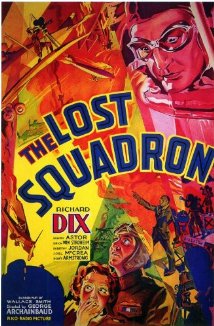
THE LOST SQUADRON
US, 1932, 79 minutes, Black and white.
Richard Dix, Mary Astor, Robert Armstrong, Dorothy Jordan, Joel Mc Rea, Erich von Stroheim, Hugh Herbert.
Directed by George Archainbaud.
In the early 1930s films with aviation themes were very popular, promoted by Howard Hughes and such directors as Howard Hawks, Hell’s Angels. This offered the opportunity for experiments in camera work, especially for flight sequences.
This is a small film within this context. It opens on 11 November 1918, some aerial dogfights, and some deaths, just before the time for the Armistice. The sequences offer an atmosphere of World War I and lead to its aftermath. There is great camaraderie between three of the fighters, played by Richard Dix, a popular star of films in the 1920s to the 1940s, Robert Armstrong, a character actor who was to appear in King Kong the next year, and Joel Mc Rea at the beginning of his 30 year star career in Hollywood. Their mechanic, with a touch of inebriation, indicating the comic style that he used in many films after this, is played by Hugh Herbert. There is some happy carousing at the end of the war.
The friends intend to keep in touch but there are some sequences where two of them try to find jobs, find that after the war their positions have been retrenched and there is little hope in finding jobs. This is an interesting observation about the treatment of veterans returning from war and the way they are treated by society, something seen 14 years later, after the end of World War II, in The Best Years of Our Lives. It was also a theme during and after the Vietnam war.
However, one of the group, Woody, is able to continue his work in flying by doing stunt sequences for Hollywood movies. The other two and their mechanic head to Hollywood, see their friend on the red carpet at a Hollywood premiere when he moves away from the crowd to talk with them. They are offered jobs, initially turning them down, but enjoying their stunt work and their flying, even some daredevil stunts.
On the personal level, Gibson, played by Richard Dix, goes to see his former sweetheart, Mary Astor at the beginning of her career, and finds that she has married a director to further her theatrical career. He is played by the veteran actor and director, Erich von Stroheim, with his characteristic Germanic authoritarianism and sneer – but also in campy be kind of way.
At the end, the film turns towards melodrama at the end when the director pours acid on one of the cables on Woody’s plane. Gibson flies up to warn him, but the realisation is too late and Woody crashes to the ground. The other pilots abduct the director, tie him up, accuse him of murder – then there is a struggle, with a gun, and the director is killed. The question is who is responsible.
Quite a lot of action is packed into the almost 80 minutes of the running time, from the war, to the difficulties for the veterans after the war, to scenes of Hollywood, and the making of World War I pictures and the work of stunt pilots.